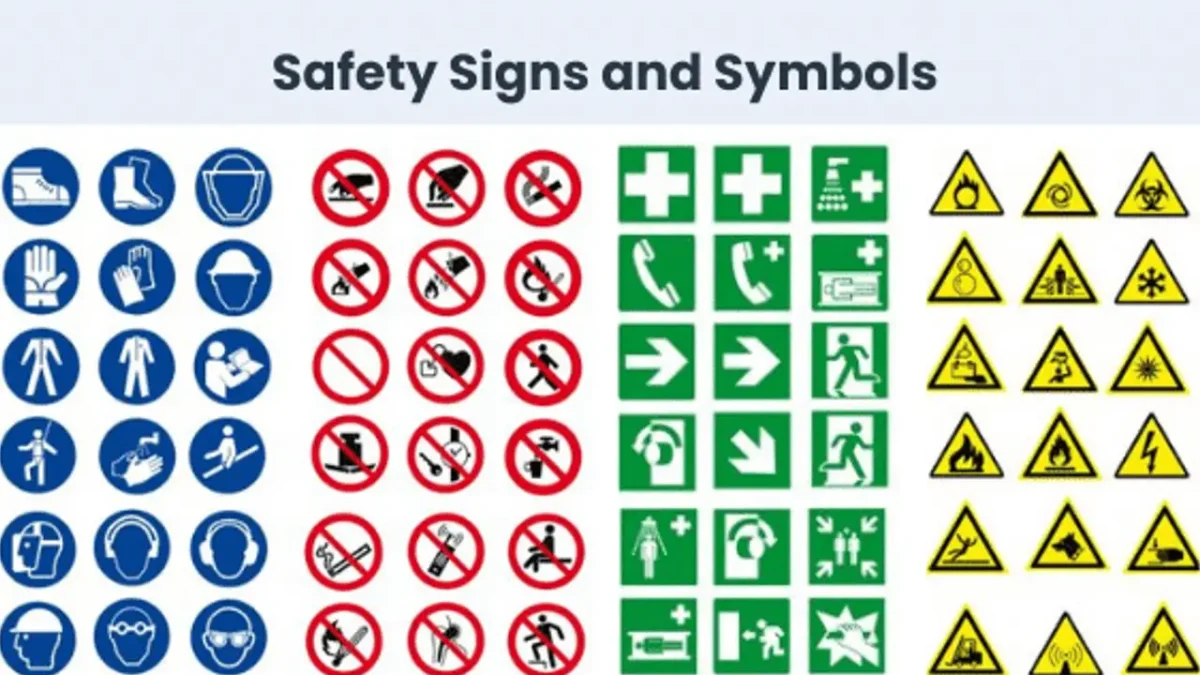A Detailed Guide to Safety Signs and Symbols

How AI & Predictive Analytics Are Transforming Safety Audits in 2025
September 24, 2025
Understanding PPE Safety: Types, Uses, and Essential Equipment
September 25, 2025What are Safety Signs and Symbols?
Safety signs and symbols are visual indicators used to communicate important information quickly and efficiently in various environments, particularly in workplaces. These signs are designed to alert individuals to potential hazards, guide them on safe practices, and provide warnings to prevent accidents. The primary purpose of safety signs and symbols is to ensure that everyone, regardless of language or literacy level, can understand and act on the information presented to maintain a safe environment.
Safety signs and symbols with names are categorized into several types based on their purpose and the type of hazard they indicate. For instance, warning signs and symbols are used to alert people to potential dangers that may not be immediately obvious, such as electrical hazards or chemical risks. These warning signs and symbols are crucial in industrial settings where specific dangers need to be clearly communicated to prevent accidents.
Another vital category includes industrial safety symbols. These are specifically designed for use in industrial environments, where the risk levels are often higher due to the nature of the work being performed. Industrial safety symbols are tailored to the specific hazards present in manufacturing plants, construction sites, and other industrial settings, making them an essential part of workplace safety protocols.
Safety warning signs are another key component of workplace safety. These signs are typically used to indicate immediate dangers, such as high voltage areas or hazardous substances, and require immediate attention to prevent injury or worse. The danger signs and symbols included in this category are designed to be highly visible and easily recognizable to ensure that workers and visitors are aware of the risks.
The use of workplace safety symbols is not limited to industrial settings alone. They are also used in offices, schools, hospitals, and other environments to communicate safety information clearly and effectively. The various types of safety signs employed in these settings include informational signs, mandatory signs, and prohibition signs, each serving a specific purpose in maintaining safety.
Understanding safety signs and meanings is crucial for ensuring that these signs are used effectively. The safety signs and meanings provide the context needed to interpret the symbols correctly and take appropriate action. This is why many organizations invest in training programs to educate their employees about the safety signs and symbols with names used in their specific work environment.
In summary, safety signs and symbols are indispensable tools in any safety management strategy. They are designed to convey critical information quickly, reducing the likelihood of accidents and ensuring that everyone is aware of potential hazards. Whether in an industrial setting, an office, or a public space, understanding and adhering to the information conveyed by these signs is essential for maintaining a safe environment.
For those involved in process safety management, conducting a fire audit, or performing a Fire Risk Assessment, the proper use of safety warning signs and an understanding of safety signs and meanings is critical. Furthermore, organizations implementing Behavior Based Safety Management should ensure that their safety communication strategy includes the effective use of safety symbols with names to reinforce safe behaviors across the board.
What are Safety Signs and Symbols?
Safety signs and symbols are crucial components of any effective safety management system. They serve as visual communication tools designed to convey important safety information quickly and universally, regardless of language barriers. These signs and symbols are employed across various industries to warn, guide, and instruct individuals about potential hazards, ensuring that everyone within a particular environment is aware of the risks and knows how to avoid them.
One of the primary functions of safety signs and symbols is to provide clear and immediate warnings about potential dangers. Warning signs and symbols are strategically placed in areas where there is a risk of harm, such as near electrical panels, hazardous chemicals, or high-traffic areas. These safety warning signs are designed to be easily recognizable, often using bright colors and distinct shapes to draw attention and communicate the level of risk involved.
In industrial settings, industrial safety symbols play a critical role in maintaining safety standards. These symbols are tailored to the specific hazards present in such environments, such as machinery risks, toxic substances, or fire hazards. The use of industrial safety symbols helps to ensure that workers are constantly reminded of the dangers they face and the precautions they need to take. Additionally, danger signs and symbols are often used to indicate severe risks that require immediate action or avoidance, further emphasizing the importance of awareness in high-risk areas.
Understanding safety signs and meanings is essential for interpreting these visual cues correctly. For example, the meanings of workplace safety symbols can range from mandatory actions, such as wearing protective gear, to prohibitive actions, like no smoking in specific areas. By incorporating safety symbols with names, organizations can further enhance the clarity and effectiveness of these signs, ensuring that every employee knows exactly what each symbol stands for.
The classification of types of safety signs helps to organize these symbols based on their function and the type of information they convey. Common types of safety signs include prohibition signs, warning signs, mandatory signs, and emergency information signs. Each type plays a distinct role in the overall safety strategy, and understanding these categories is crucial for implementing a comprehensive safety plan.
In the context of process safety management, a well-designed system of safety signs and symbols can significantly reduce the likelihood of accidents and improve response times in emergency situations. Similarly, during a fire audit or Fire Risk Assessment, the presence and proper placement of safety warning signs can make a critical difference in mitigating fire hazards and ensuring a safe evacuation.
Furthermore, integrating Behavior Based Safety Management into an organization’s safety culture means ensuring that all employees are not only familiar with safety signs and symbols but also understand their importance in everyday operations. This understanding fosters a proactive approach to safety, where individuals take ownership of their actions and contribute to a safer work environment for everyone.
safety signs and symbols are indispensable tools for maintaining a safe and healthy workplace. Whether used in industrial settings, offices, or public spaces, these symbols provide clear, concise, and universally understood instructions that help prevent accidents and save lives. By understanding the various types of safety signs, their meanings, and their proper usage, organizations can create a safer environment for all.
Types of Safety Symbols (with Examples)
Safety signs and symbols are divided into distinct categories, each serving a specific purpose in maintaining safety standards. Understanding these types of safety signs is crucial for ensuring proper compliance and safeguarding individuals in various environments. Below, we delve into four main types: Prohibition, Warning, Mandatory, and Emergency symbols, along with examples to illustrate their significance.
Prohibition Symbols
Prohibition safety symbols are designed to inform individuals of actions that are not permitted in a specific area. These safety symbols with names typically feature a red circle with a diagonal line running through it, universally recognized as a “no” symbol. A common example is the “No Smoking” sign, which is critical in areas with flammable materials. This type of symbol helps prevent behaviors that could lead to accidents or hazardous situations. For instance, a “No Entry” symbol prevents unauthorized access to dangerous zones, thereby ensuring safety and compliance.
Warning Symbols
Warning signs and symbols play a vital role in alerting individuals to potential hazards that may not be immediately apparent. These safety warning signs often feature a yellow triangle with a black border and symbol, such as an exclamation mark or a lightning bolt, depending on the risk. For example, a “High Voltage” sign warns of electrical hazards, while a “Slip Hazard” sign indicates a potentially slippery surface. In industrial environments, industrial safety symbols like “Toxic Material” warnings are crucial for preventing exposure to harmful substances. Understanding safety signs and meanings in this category is essential for avoiding accidents and ensuring a safe workplace.
Mandatory Symbols
Mandatory safety symbols are used to indicate actions that must be carried out to maintain safety. These symbols are often depicted in a blue circle with a white pictogram, clearly instructing individuals on required behaviors. For example, a “Wear Hard Hats” symbol is mandatory on construction sites, ensuring that workers protect themselves from head injuries. Other examples include symbols like “Wear Safety Goggles” in labs or areas where eye protection is crucial. These workplace safety symbols are integral to enforcing safety protocols and ensuring that everyone follows necessary precautions.
Emergency Symbols
Emergency safety symbols guide individuals toward safety equipment, exits, or other emergency-related locations. Typically green and white, these symbols are designed to be easily identifiable in high-stress situations. Examples include the “First Aid” symbol, which directs people to medical supplies, and the “Fire Exit” symbol, which shows the quickest route to safety in case of a fire. Understanding and recognizing these safety signs and symbols with names is vital for swift and safe evacuation during emergencies. The safety signs and meanings in this category ensure that everyone knows how to respond quickly in crisis situations, reducing the risk of injury or loss of life.
these types of safety signs—Prohibition, Warning, Mandatory, and Emergency—are essential components of any safety management system. Each category serves a unique function, from preventing dangerous actions to guiding individuals during emergencies. By familiarizing yourself with these safety signs and symbols, you contribute to creating a safer environment, whether in industrial settings, offices, or public spaces. Understanding and correctly interpreting these symbols can significantly reduce accidents and enhance overall safety.
What are GHS Pictograms?
GHS Pictograms: Hazards and Classification
GHS (Globally Harmonized System) pictograms are critical tools in identifying and understanding the hazards associated with various chemicals. These safety signs and symbols provide immediate visual cues about the risks that different substances present, making them essential for ensuring safety in workplaces that handle chemicals. Below are key GHS pictograms, their meanings, and the classifications they represent:
Health Hazard
The health hazard pictogram is symbolized by a silhouette of a person with damage to the chest. This pictogram pertains to chemicals that can cause severe, long-term health effects. Substances marked with this symbol may be carcinogenic, mutagenic, or have reproductive toxicity, causing significant health damage over time.
Flammable
The flammable pictogram, represented by a flame, indicates chemicals or gases that can easily catch fire. These substances may ignite when exposed to air, sparks, or other ignition sources. In industries dealing with flammable materials, recognizing this symbol is crucial for preventing fires and ensuring proper storage and handling practices.
Irritant/Hazardous to Ozone Layer
Symbolized by a large exclamation mark, this pictogram covers a broad range of hazards. It represents chemicals that may cause skin or eye irritation, or respiratory issues, as well as substances that are hazardous to the ozone layer. Understanding this symbol helps in taking necessary precautions to protect both individual health and the environment.
Gas Under Pressure
The gas under pressure pictogram, shown as a gas cylinder, highlights the dangers of gases stored under high pressure. These gases can become explosive if exposed to heat or if the container is damaged. Some refrigerated gases can also cause burns or other injuries upon contact, making this symbol critical for safe handling.
Corrosion
The corrosion pictogram features an image of a substance corroding material and skin. It is used to mark chemicals that can cause severe skin burns and eye damage upon contact. These substances may also corrode metals, necessitating special handling and storage procedures to prevent accidents.
Explosives
Depicted as an exploding bomb, the explosives pictogram warns of chemicals that can detonate under certain conditions. These materials pose serious risks, requiring strict controls to prevent any conditions that might trigger an explosion.
Oxidizers
The oxidizers pictogram, symbolized by a flame over a circle, indicates chemicals that can cause or intensify a fire or explosion when they come into contact with other substances. Recognizing and properly managing these chemicals is essential in any environment where they are used.
Hazardous to the Environment
The hazardous to the environment pictogram, featuring a dead tree and fish, marks chemicals that can cause long-lasting environmental damage. These substances require careful disposal and handling to minimize their impact on ecosystems.
Toxic :- The toxic pictogram is shown with a skull and crossbones, indicating chemicals that can cause serious health effects or death, even in low doses. Extreme caution is required when handling these substances to prevent exposure and protect worker safety.
By understanding these GHS pictograms and their meanings, you can effectively navigate the hazards associated with chemicals and ensure that safety protocols are properly followed. These safety symbols with names are an integral part of any safety program, helping to mitigate risks and protect both people and the environment.
Create a Safe Workplace Culture with Training on the Proper Usage of Safety Signs and Symbols
Establishing a safe workplace culture begins with comprehensive training on the proper usage of safety signs and symbols. These visual tools are essential for communicating hazards, guiding safe behaviors, and preventing accidents. Ensuring that every employee understands safety signs and meanings is crucial to maintaining a safe working environment.
Training programs should focus on educating employees about the different types of safety signs they may encounter in their daily operations. This includes recognizing warning signs and symbols that alert them to potential dangers, such as high-voltage areas, slippery surfaces, or hazardous chemicals. By familiarizing employees with industrial safety symbols, you help them identify and avoid specific risks associated with their tasks, such as exposure to toxic substances or moving machinery.
Effective training must also emphasize the significance of safety warning signs in preventing injuries. For example, workers need to understand how danger signs and symbols are used to highlight areas where immediate threats to health or safety exist, such as in confined spaces or areas with explosive materials. By incorporating safety symbols with names into training materials, employees can quickly associate each symbol with its corresponding hazard, reinforcing their ability to respond appropriately in high-risk situations.
Additionally, the use of workplace safety symbols in training sessions can enhance awareness of mandatory safety practices, such as wearing protective equipment or following specific procedures. These symbols serve as constant reminders of the precautions necessary to avoid accidents, fostering a proactive approach to safety.
Creating a safe workplace culture through training on safety signs and symbols not only protects employees but also boosts overall productivity by minimizing downtime caused by accidents. When workers are well-versed in the safety signs and meanings relevant to their jobs, they can perform their duties more confidently and effectively, knowing they are equipped to recognize and mitigate potential hazards.
FAQs
What are 10 Safety Signs?
Safety signs and symbols are essential for communicating hazards and guiding safe behavior in various environments. Here are 10 common safety signs:
- No Smoking (Prohibition)
- Fire Exit (Emergency)
- Wear Hard Hat (Mandatory)
- Danger High Voltage (Warning)
- Flammable Materials (Warning)
- First Aid (Emergency)
- Slippery When Wet (Warning)
- No Entry (Prohibition)
- Corrosive Materials (Warning)
- Emergency Assembly Point (Emergency)
These types of safety signs are used universally to ensure a safer workplace by providing clear instructions and warnings.
What is the Meaning of Safety Signs and Symbols?
Safety signs and symbols are visual cues that communicate essential safety information at a glance. The safety signs and meanings are designed to prevent accidents by clearly indicating hazards, required actions, or emergency information. For example, warning signs and symbols like a yellow triangle with an exclamation mark alert workers to potential dangers, while industrial safety symbols such as the flame icon indicate flammable materials. Understanding safety signs and symbols with names is critical for anyone working in environments where hazards are present, as it ensures that safety measures are followed effectively.
What are the 7 Safety Signs?
The seven main types of safety signs include:
- Prohibition Signs (e.g., No Smoking)
- Warning Signs (e.g., Danger High Voltage)
- Mandatory Signs (e.g., Wear Protective Equipment)
- Emergency Information Signs (e.g., First Aid)
- Fire Safety Signs (e.g., Fire Exit)
- Hazard Signs (e.g., Toxic Material)
- Safe Condition Signs (e.g., Emergency Exit)
These workplace safety symbols help create a safer environment by providing clear and direct instructions for avoiding hazards and responding to emergencies. Understanding these safety signs and symbols is crucial for maintaining a safe workplace.




